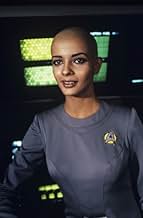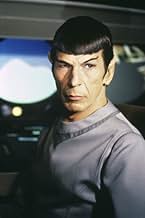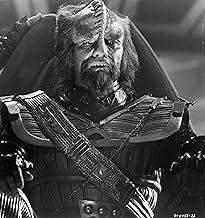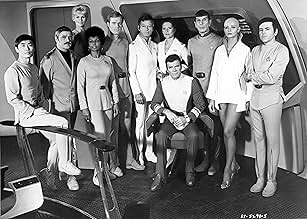When an alien spacecraft of enormous power is spotted approaching Earth, Admiral James T. Kirk resumes command of the overhauled USS Enterprise in order to intercept it.When an alien spacecraft of enormous power is spotted approaching Earth, Admiral James T. Kirk resumes command of the overhauled USS Enterprise in order to intercept it.When an alien spacecraft of enormous power is spotted approaching Earth, Admiral James T. Kirk resumes command of the overhauled USS Enterprise in order to intercept it.
- Nominated for 3 Oscars
- 4 wins & 21 nominations total
John Gowans
- Assistant to Rand
- (as John D. Gowans)
- Director
- Writers
- All cast & crew
- Production, box office & more at IMDbPro
Storyline
Did you know
- TriviaWhen Captain Kirk addresses the crew before launching, many of the extras were noted Star Trek fans, including Bjo Trimble, co-organizer of the letter-writing campaign that kept Star Trek (1966) alive for a third season.
- GoofsWhen flying past Jupiter, three consecutive shots of Jupiter and its moons are shown. The first and third are from the POV of the ship as it approaches and passes Jupiter, and show the sunshine on planet and several moons coming from the port aft. The second shot shows the opposite angle of the oncoming ship, and the sunshine on the planet and 4 moons is coming from a different direction on each body, none of them from the port aft.
- Crazy creditsEnd title: "The human adventure is just beginning."
- Alternate versionsOn November 6, 2001, the Director's Edition supervised by Robert Wise was released on DVD and widescreen VHS, running 136 minutes. The material added to the film consists of the following:
- The landscape of Vulcan was changed to include a yellowish sky and new landscape featuring massive statues. All other footage was tinted gold.
- The matte painting of the Golden Gate Bridge in the scene where Kirk arrives at Starfleet Headquarters was replaced by a new CGI scene that shows Kirk's shuttle arriving at Starfleet. It is actually slightly longer than the original version.
- The matte painting of Starfleet Command was improved with CGI effects, including an original series shuttle launched in the background.
- In a close-up shot when Kirk first sees the new Enterprise from his shuttle, the image of the ship was superimposed over Kirk's face as a reflection in the shuttle's window.
- After Kirk leaves the bridge, a short conversation between Sulu, Uhura and an alien officer was inserted.**
- A new CGI shot of the Earth is shown on the viewscreen when the Enterprise leaves the planet.
- A new CGI effect showing one of the Enterprise's nacelles was inserted into the window when Kirk, Spock and McCoy speak on the observation deck.
- A new CGI shot was inserted which shows V'Ger's second energy torpedo vanishing before it could strike the Enterprise.
- The energy probe that invades the bridge now approaches in a CGI exterior shot.
- A new CGI shot shows the V'Ger vessel entering Earth orbit.
- The scene in which Chekov burns his hand is much longer and shows Lt. Ilia healing him with her empathic powers instead of Nurse Chapel.**
- The long walk to V'Ger was totally redone. There is now a walkway that materializes out of thin air, compared to the endless field in the original version.
- The Enterprise's voyage to the center of V'Ger is slightly extended. It has a scene of Spock sharing a tear "for V'Ger" and Scotty ordered to self-destruct the ship if the landing party is unsuccessful.**
- The small black "empty matte" in the window when Decker and Ilia confront each other in the recreation deck was replaced with a CGI shot of the V'Ger cloud interior.
- The final explosion of V'Ger was slightly extended. The shot from the original version remained intact, but a new element of the vessel imploding its energy for the explosion was added.
- New opening titles were commissioned for the film's opening. The opening titles now have a slight fading effect and are now seen over a background of stars. The text is colored a bright gold, compared to the original version's white.
- The explosion in the wormhole was redone. There is now an exterior shot of the asteroid exploding and the wormhole disintegrating. Additionally, the viewfinder in the next shot is enhanced to show sparks and debris.
- The final message to the audience, "The human adventure is just beginning", was altered. In the original version, the starfield cuts away to a blank title card showing the text. In the Director's Edition, the starfield was extended by a few seconds to allow the text, colored bright gold, to fade into the picture.
- The ending credits were slightly altered. The text, as with the opening titles and the final "human adventure" text, was changed color, from white to a bright gold. Additionally, the music was slightly extended to add new Director's Edition credits.
- An all-new sound mix was commissioned, keeping the music and dialog intact, and adding new effects for almost all scenes. For example, the Enterprise computer voice alarms are now replaced with klaxon sirens, the lightning effects have new echoes, and a blend of Enterprise bridge sound effects from the original Star Trek series, Star Trek II: The Wrath of Khan, and Star Trek VI: The Undiscovered Country have been added into the background of scenes taking place on the bridge. The new mix is in Dolby 5.1 EX Surround.
- The footage from 1979 was digitally restored and remastered, and combined with the new CGI elements.
- The opening overture has been restored to its full length. It is also played over a CGI starfield, rather than the blank screen in the original version.
- A slight dialog alteration was made: In the 1979 and 1983 versions, the V'Ger cloud is said to be "over 82 AUs in diameter" which equals 7.626 billion miles across - much too large for the Enterprise to realistically travel to the heart of the cloud at subwarp speeds within a reasonable length of time. For the Director's Edition, the Epsilon 9 commander's dialog was altered so that the cloud is now said to be a (somewhat) more reasonable "over 2 AUs", or 186 million miles.
- The producers of the Director's Edition submitted the film for re-rating by the MPAA, hoping for a PG rating rather than the original G rating which they believed carried a negative association; the basis for the higher rating was the intensified soundtrack. Oddly, when the original theatrical version was released on DVD and Blu-ray in 2009, it carried no MPAA rating.
- Scenes previously available in the "special longer version."
- ConnectionsEdited into Star Trek II: The Wrath of Khan (1982)
- SoundtracksTheme from 'Star Trek: The television Series'
Written by Alexander Courage and Gene Roddenberry
Featured review
'Star Trek: The Motion Picture', originally released Friday, December 7th, 1979. - ORIGINAL Theatrical Version, 1979, Running Time 2hrs&12mn, Rated "G" by the MPAA - SPECIAL Extended Version, 1983, Running Time 2hrs&23mn, Rated "G" by the MPAA - The DIRECTOR's Edition, 2001, Running Time 2hrs&16mn, Rated "PG" by the MPAA - CONTENT for all three versions includes: Mild Adult Language, Mild Sexual Innuendo and Mild Violence.
My take *** (Out of ****) - or 7/10 on the IMDb Scale.
'Star Trek: The Motion Picture' is the big screen debut of the continuation of the science fiction television series 'Star Trek'. The show chronicled the adventures of the crew of the space-going USS Enterprise. The ship explored the galaxy during a historic five-year mission under the command of the charismatic Captain James T. Kirk. Other crew members included the logical first officer/science officer Spock, a half human/half Vulcan hybrid (Vulcans are an alien race, complete with pointed ears) and the passionate country doctor Leonard "Bones" McCoy. The TV series ran on NBC from 1966 to 1969.
'Star Trek' takes place in the latter half of the 23rd Century. Mankind has formed alliances with many alien races from planets throughout the galaxy, collectively forming The United Federation of Planets. These societies thrive peacefully and continue to develop together and independently. To protect this Federation from hostiles and seek out new lifeforms and new civilizations is Starfleet. This organization is diplomatic and scientific, yet serves as a military force as needed.
The movie opens two & 1/2 years after the completion of the starship Enterprise's five year mission. The spaceship is orbiting Earth, in a dry-dock of sorts, completing a complex overhaul. The planet Earth is in the path of a potential destructive alien intruder. The now Admiral Kirk (William Shatner) doesn't have time to spare during this crisis. He takes a grade reduction to captain, wrestling command of the Enterprise away from a less experienced skipper (Stephen Collins), and sets out to counter the alien threat before it can reach Earth. Most of his original crew has been re-assembled for this undertaking. Shortly after Kirk & team embark to stop the intruder, Spock (Leonard Nimoy) joins them on their quest.
'Star Trek: The Motion Picture' trades in on the action, good drama, suspense and wit the TV series offered to a degree. Kirk & company are here pretty much for the ride, instead of being the leaders they're known as. The movie moves at a slow pace, gradually getting into the intricacies of the alien menace. There's a lot of time adoring spaceships as they travel through space. There's not much in the way of real character development.
Despite the compromises, 'Star Trek: The Motion Picture' works on some level. It's interesting to see the familiar crew in action once again. There are some very fundamental questions asked in the movie that we all have asked ourselves. I found those questions to be intriguing. ST:TMP wants to be intellectual and it succeeds a lot of the time.
Jerry Goldsmith, the film's music composer, provides us with one of the most memorable scores in motion picture history. This is a huge plus for a movie noticeably deficient in personality. This lovely score helps to make up for that. The film almost plays like an elaborate special effects music video set to this grand rousing score. I appreciated the film on this level too.
The special effects by John Dykstra were highly imaginative for the late 1970s. They still hold up well over the decades and continue to enthrall me, especially with the mystery of the alien intruder. The intruder sound effects also succeed in giving me an appropriate sense of awe and dread.
The 2001 Director's Edition is the best version of the movie. The theatrical version was rushed to make the movie's scheduled release date. It was regarded by director Robert Wise as incomplete. 'The Director's Edition' restores Wise's planned vision for the movie. This version streamlines the pace of the movie, adds a little more depth to the characters and has the originally desired sound-mix and completed special effects restored for this edition.
'Star Trek: The Motion Picture' was followed by nine sequels to date and four new TV series. There is an eleventh movie currently in production.
'Star Trek: The Motion Picture' was a shaky start for the launch of the 'Star Trek' film series. It's better to simply except this picture for what it is, rather than for what it isn't. It's not a perfect movie, but it did what it set out to do. It invited me for a journey offering good special effects, a great music score and a beloved crew back on the job. The movie also gave me something to think about. It could have been a better movie, but it's still a marginally satisfying one. Though clearly not for everyone, I recommend it to those who would welcome the philosophical ride it offers.
My take *** (Out of ****) - or 7/10 on the IMDb Scale.
'Star Trek: The Motion Picture' is the big screen debut of the continuation of the science fiction television series 'Star Trek'. The show chronicled the adventures of the crew of the space-going USS Enterprise. The ship explored the galaxy during a historic five-year mission under the command of the charismatic Captain James T. Kirk. Other crew members included the logical first officer/science officer Spock, a half human/half Vulcan hybrid (Vulcans are an alien race, complete with pointed ears) and the passionate country doctor Leonard "Bones" McCoy. The TV series ran on NBC from 1966 to 1969.
'Star Trek' takes place in the latter half of the 23rd Century. Mankind has formed alliances with many alien races from planets throughout the galaxy, collectively forming The United Federation of Planets. These societies thrive peacefully and continue to develop together and independently. To protect this Federation from hostiles and seek out new lifeforms and new civilizations is Starfleet. This organization is diplomatic and scientific, yet serves as a military force as needed.
The movie opens two & 1/2 years after the completion of the starship Enterprise's five year mission. The spaceship is orbiting Earth, in a dry-dock of sorts, completing a complex overhaul. The planet Earth is in the path of a potential destructive alien intruder. The now Admiral Kirk (William Shatner) doesn't have time to spare during this crisis. He takes a grade reduction to captain, wrestling command of the Enterprise away from a less experienced skipper (Stephen Collins), and sets out to counter the alien threat before it can reach Earth. Most of his original crew has been re-assembled for this undertaking. Shortly after Kirk & team embark to stop the intruder, Spock (Leonard Nimoy) joins them on their quest.
'Star Trek: The Motion Picture' trades in on the action, good drama, suspense and wit the TV series offered to a degree. Kirk & company are here pretty much for the ride, instead of being the leaders they're known as. The movie moves at a slow pace, gradually getting into the intricacies of the alien menace. There's a lot of time adoring spaceships as they travel through space. There's not much in the way of real character development.
Despite the compromises, 'Star Trek: The Motion Picture' works on some level. It's interesting to see the familiar crew in action once again. There are some very fundamental questions asked in the movie that we all have asked ourselves. I found those questions to be intriguing. ST:TMP wants to be intellectual and it succeeds a lot of the time.
Jerry Goldsmith, the film's music composer, provides us with one of the most memorable scores in motion picture history. This is a huge plus for a movie noticeably deficient in personality. This lovely score helps to make up for that. The film almost plays like an elaborate special effects music video set to this grand rousing score. I appreciated the film on this level too.
The special effects by John Dykstra were highly imaginative for the late 1970s. They still hold up well over the decades and continue to enthrall me, especially with the mystery of the alien intruder. The intruder sound effects also succeed in giving me an appropriate sense of awe and dread.
The 2001 Director's Edition is the best version of the movie. The theatrical version was rushed to make the movie's scheduled release date. It was regarded by director Robert Wise as incomplete. 'The Director's Edition' restores Wise's planned vision for the movie. This version streamlines the pace of the movie, adds a little more depth to the characters and has the originally desired sound-mix and completed special effects restored for this edition.
'Star Trek: The Motion Picture' was followed by nine sequels to date and four new TV series. There is an eleventh movie currently in production.
'Star Trek: The Motion Picture' was a shaky start for the launch of the 'Star Trek' film series. It's better to simply except this picture for what it is, rather than for what it isn't. It's not a perfect movie, but it did what it set out to do. It invited me for a journey offering good special effects, a great music score and a beloved crew back on the job. The movie also gave me something to think about. It could have been a better movie, but it's still a marginally satisfying one. Though clearly not for everyone, I recommend it to those who would welcome the philosophical ride it offers.
- MC1-Bjornson
- May 24, 2007
- Permalink
Details
- Release date
- Country of origin
- Official site
- Languages
- Also known as
- Viaje a las estrellas
- Filming locations
- Yellowstone National Park, Wyoming, USA(portions of planet Vulcan sequence filmed at Minerva Terrace)
- Production companies
- See more company credits at IMDbPro
Box office
- Budget
- $35,000,000 (estimated)
- Gross US & Canada
- $82,604,699
- Opening weekend US & Canada
- $11,926,421
- Dec 9, 1979
- Gross worldwide
- $82,676,805
- Runtime2 hours 23 minutes
- Color
- Sound mix
- Aspect ratio
- 2.39 : 1
Contribute to this page
Suggest an edit or add missing content

Top Gap
By what name was Star Trek: The Motion Picture (1979) officially released in India in Hindi?
Answer





































